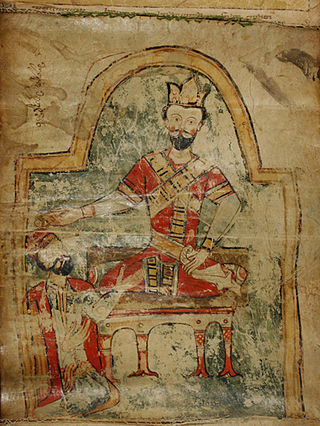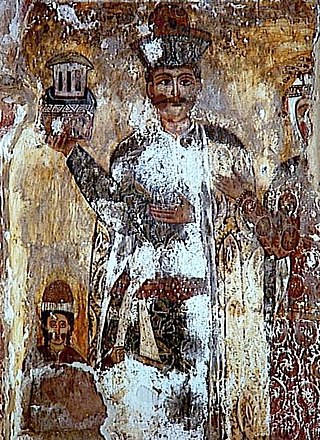| Battle of Murjakheti | |||||||||
|---|---|---|---|---|---|---|---|---|---|
| |||||||||
| Belligerents | |||||||||
| | | ||||||||
| Commanders and leaders | |||||||||
| | | ||||||||
The Battle of Murjakheti was fought between the armies of the Kingdom of Imereti and the Samtskhe-Saatabago at the place of Murjakheti near Akhalkalaki, on 12 August 1535. [1]
| Battle of Murjakheti | |||||||||
|---|---|---|---|---|---|---|---|---|---|
| |||||||||
| Belligerents | |||||||||
| | | ||||||||
| Commanders and leaders | |||||||||
| | | ||||||||
The Battle of Murjakheti was fought between the armies of the Kingdom of Imereti and the Samtskhe-Saatabago at the place of Murjakheti near Akhalkalaki, on 12 August 1535. [1]
During Qvarqvare III's reign Persian influence on Samtskhe was growing day by day. Because of that Ottomans greatly damaged the country and especially it's southwestern region. Meskhetian lords had recognized that under Qvarqvare's rule Samtskhe would finally turn to the Enemy's hands. They made an alliance with the Georgian kings, Bagrat III of Imereti and Luarsab I of Kartli to end up Jaqelian rule and protect Samtskhe from dominant Muslim empires (Ottomans and Safavids). [2]
In 1535 King Bagrat III with help of prince Rostom Gurieli and Mingrelian allies invaded Samtskhe. He defeated and captured Qvarqvare III, the atabeg was captured by Gurieli's cup-bearer Isak Artumeladze, and eventually delivered to Bagrat. Georgians had annexed Samtskhe-Saatabago. Qvarqvare died in prison, while Rostom of Guria was awarded Adjara and Lazeti. [3]

A few years later, Qvarqvare's survived youngest son Kaikhosro II requested Ottomans to expel Imeretian and Kartlian forces from Samtskhe. The Ottomans retaliated with a major invasion: Bagrat and Rostom were victorious at the Battle of Karagak in 1543, but decisively defeated, in 1545, at the Battle of Sokhoista, where Rostom's son Kaikhosro was killed. [4] [5] And Samtskhe became vassal of the Ottoman Empire. [6]

George VIII was de facto last king (mepe) of the formerly united Kingdom of Georgia from 1446 to 1465, though the kingdom was already splintered and embroiled in a civil war. Defeated by his rivals, he was left with an eastern province Kakheti alone, where he reigned as George I from 1465 until his death, founding a local branch of the Bagrationi royal house.
Constantine II, of the Bagrationi dynasty, was the 23rd and last king (mepe) of United Georgia from 1478 until his death. Early in the 1490s, he had to recognise the independence of his rival rulers of Imereti and Kakheti, and to confine his power to Kartli. In 1505, Constantine II died, and was succeeded by his son David X.

The Principality of Guria was a historical state in Georgia. Centered on modern-day Guria, a southwestern region in Georgia, it was located between the Black Sea and Lesser Caucasus, and was ruled by a succession of twenty-two princes of the House of Gurieli from the 1460s to 1829. The principality emerged during the process of fragmentation of a unified Kingdom of Georgia. Its boundaries fluctuated in the course of permanent conflicts with neighboring Georgian rulers and the Ottoman Empire, and the principality enjoyed various degrees of autonomy until being annexed by Imperial Russia in 1829.

Bagrat III (1495-1565), of the Bagrationi dynasty, was a King of Imereti from April 1, 1510, to 1565. He succeeded upon the death of his father, Alexander II, and faced repeated assaults from the Ottoman Turks as well as the conflicts with his ostensible vassal princes of Mingrelia, Guria, and Abkhazia who were frequently joining the enemy.
Giorgi III Gurieli, of the Georgian House of Gurieli, was Prince of Guria from 1669 to 1684 and King of Imereti from 1681 to 1683. He was energetically involved in civil wars in western Georgian polities, which he sought to bring under his sway. He was killed in battle while trying to recover the lost throne of Imereti.
The Battle of Sokhoista was fought between the Ottoman and Georgian armies at the Sokhoista field in what is now northeastern Turkey in 1545. It was the last attempt of the separate Georgian dynasts to fight as one unit against the Ottoman expansion, but ended in their decisive defeat. This might be the same battle as mentioned by Rüstem Pasha to have been fought at nearby Zivin.

The Samtskhe-Saatabago or Samtskhe Atabegate, also called the Principality of Samtskhe, was a Georgian feudal principality in Zemo Kartli, ruled by an atabeg (tutor) of Georgia for nearly three and a half centuries, between 1268 and 1625. Its territory consisted of the modern-day Samtskhe-Javakheti region and the historical region of Tao-Klarjeti.

The Kingdom of Kartli was a late medieval/early modern monarchy in eastern Georgia, centred on the province of Kartli, with its capital at Tbilisi. It emerged in the process of a tripartite division of the Kingdom of Georgia in 1478 and existed, with several brief intervals, until 1762 when Kartli and the neighbouring Georgian kingdom of Kakheti were merged through dynastic succession under the Kakhetian branch of the Bagrationi dynasty. Through much of this period, the kingdom was a vassal of the successive dynasties of Iran, and to a much shorter period Ottoman Empire, but enjoyed intermittent periods of greater independence, especially after 1747.

Mariam Dadiani was a daughter of Manuchar I Dadiani, Prince of Mingrelia, by his second wife, Tamar Jaqeli. Thrice married, successively to Simon I Gurieli, Prince of Guria, in 1621, King Rostom of Kartli in 1638, and the latter's adopted son and successor, King Vakhtang V in 1658.
Constantine was a Georgian royal prince (batonishvili) of the Bagrationi dynasty of Imereti.
Dedisimedi was a Georgian noblewoman of the House of Mukhrani, a collateral branch of the royal Bagrationi dynasty. She was princess consort of Samtskhe as wife of Kaikhosro II Jaqeli and regent for her son Qvarqvare IV Jaqeli. She played a leading role in a civil war that plagued Samtskhe from 1576 to 1578. After the Ottoman takeover of her principality, Dedisimedi retired to Kartli, leaving the government to her son, Manuchar II Jaqeli, who continued to rule as an Ottoman pasha.

Levan I Dadiani was a member of the House of Dadiani and ruler of Odishi, that is, Mingrelia, in western Georgia. He succeeded on the death of his father, Mamia III Dadiani, as eristavi ("duke") of Odishi and ex officio mandaturt-ukhutsesi of Imereti in 1533. Dadiani's break with the king of Imereti brought about his downfall and imprisonment in 1546. He was able to escape and regain his possessions, securing Ottoman support for his independence from Imereti.
Kaikhosro II Jaqeli, of the House of Jaqeli, son of Qvarqvare III, was prince of Samtskhe, ruling nominally in 1545–1573. Invested as a puppet ruler by the Ottomans in 1545, Kaikhosro II's tenure was marred by incessant Iranian–Ottoman rivalry, as well as uneasy relations with neighboring Georgian polities, and internecine feuds. The western part of his principality became quickly assimilated by the Ottomans and formed into a paşalık, while the eastern part came under Iranian suzerainty. In 1570, as a result of continued Ottoman aggression, Kaikhosro was forced to seek direct assistance from his suzerain king Tahmasp I at the Iranian royal court, where he died three years later as well.
Rostom Gurieli, of the House of Gurieli, was Prince of Guria from 1534 until his death in 1564. Alongside his royal suzerain, Bagrat III of Imereti, Rostom fought against the expanding Ottoman Empire to which he lost parts of his principality. Rostom's relations with Bagrat III subsequently deteriorated over his support to the king's defiant vassal, Levan I Dadiani.
Giorgi II Gurieli, of the House of Gurieli, was Prince of Guria from 1564 to 1583 and again from 1587 to 1600. Succeeding on the death of his father Rostom Gurieli, Giorgi's rule over his small principality, located in southwest Georgia, was a period of conflict with the neighboring Dadiani of Mingrelia and increasing assertiveness of the Ottomans whom Gurieli submitted in 1581. His reign was interrupted, from 1583 to 1587, by a Mingrelian invasion, but Giorgi was able to resume the throne with Ottoman support.
Kaikhosro II Gurieli, of the House of Gurieli, was Prince of Guria, in western Georgia, from 1685 to 1689. He vied for the control of Guria with his uncle, Malakia Gurieli, who he had blinded. Kaikhosro was eventually killed by agents of the Ottoman pasha of Akhaltsikhe, who sought regional hegemony in southwestern Caucasus.
Qvarqvare III Jaqeli (1469–1535) was a Georgian ruling Prince and Atabeg of Samtskhe-Saatabago during 1518–1535. Member of the Jaqeli family and son of Atabeg Kaikhosro I Jaqeli. His failure to capture the throne at the death of his father Kaikhosro may have been caused by the ambition of his uncle Mzetchabuki, who had seized Atabeg's title from him. Despite this Mzetchabuk Jaqeli declared Qvarqare as his successor. During his uncle's reign Qvarqvare actively involved in state affairs. In 1515 ill Mzetchabuk resigned from the throne and came to the Monastery as a monk. Qvarqvare couldn't ascend to the Meskhetian throne, because his second uncle Manuchar I had revolted. Qvarqvare went to Safavid Persia, became vassal of Shah Ismail I and lived at his court in Tabriz until his accession. In 1518 Qvarqvare commanded Qizilbash army and invaded Samtskhe. Persians dethroned Manuchar I and placed Qvarqvare on the throne. Manuchar invited Ottomans to fight against Safavids and overthrow his nephew, but Qvarqvare's forces defeated him at the battle near Erzurum, after which Manuchar escaped to the Ottoman empire. During Qvarqvare's reign Persian influence on Samtskhe was growing day by day. Because of that Turks greatly damaged the country and especially its southwestern region. Meskhetian lords had recognized that under Qvarqvare's rule Samtskhe would finally turn to the Enemy's hands. They made an alliance with the Georgian kings, Bagrat III of Imereti and Luarsab I of Kartli to end up Jaqelian rule and protect Samtskhe from dominant Muslim empires. In 1535 King Bagrat III invaded Samtskhe. He defeated and captured Qvarqvare III at the Battle of Murjakheti near Akhalkalaki, Georgians had annexed Principality of Samtskhe. Qvarqvare died in prison. A few years later, his survived youngest son Kaikhosro II requested Ottomans to expel Imeretian and Kartlian forces from Samtskhe. In 1545, at the Battle of Sokhoista, Kaikhosro defeated Bagrat III, after which he reinstated his legitimate throne. Samtskhe became vassal of the Ottoman empire. Qvarqvare III's descendants ruled Samtskhe-Saatabago and then Childir Eyalet until 1820s.

Qvarqvare IV Jaqeli was a Georgian Prince and Atabeg of Samtskhe-Saatabago, ruling nominally in 1573–1581. He was member of the Jaqeli family and the son of Kaikhosro II Jaqeli. During his nominal reign Meskhetian lords revolted several times against Jaqelian rule. Uprisings were suppressed by Ottomans. In 1578 Ottomans started new war against Safavid Persia for the hole territory of Caucasus. Lala Mustafa Pasha invaded Georgia. Qvarqvare IV obeyed him. Pasha had decided to send Qvarqvare and his younger brother Manuchar to Constantinople for recognizing Ottoman absolute rule in Samtskhe. Qvarqvare left the government to his mother, Dedisimedi and went to the capital of the Ottoman Empire. In 1579 by the order of Sultan Murad III Ottomans divided Samtskhe-Saatabago into eight Sanjaks and established Childir Eyalet on the lands of Meskheti. Qvarqvare IV was appointed as Christian ruler of Childir Eyalet, but his brother Manuchar converted to Islam under the name of Mustafa and became the Ottoman Pasha. Qvarqvare died childless in 1581 and was succeeded by his Muslim brother Manuchar II.
The Battle of Karagak was fought between the armies of the Kingdom of Imereti and the Ottoman Empire at the place of Karagak, Meskheti, in 1543.

The collapse of the Georgian realm was a political and territorial fragmentation process that resulted in the dynastic triumvirate military conflict of the Bagrationi monarchs and war of succession in the united Kingdom of Georgia culminating during the second half of the 15th century.
{{cite book}}: CS1 maint: location missing publisher (link){{cite book}}: CS1 maint: location missing publisher (link)